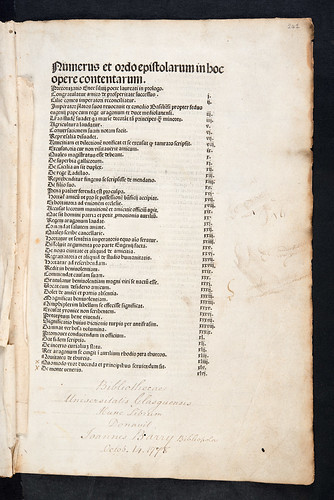Pius II, Pont. Max: Epistolae familiares. De Duobus amantibus Euryalo et Lucretia. Descriptio urbis Viennensis.
Edited by Nicolaus von Wyle.
Nuremberg: Anton Koberger, 16 Sept. 1481.
Fol. [18 2-386 3910 406]. [246] leaves, leaf 241 blank.
ISTC ip00717000; GW M33692; Goff P717; BMC II 421 (IB. 7232); Bod-inc P-318; CIBN P-412; BSB-Ink P-520.
Includes also De curialium miseria; De educatione puerorum. Poggius Florentinus: Epistola de balneis; Epistola de morte Hieronymi Pragensis. Leonardus Brunus Aretinus: De duobus amantibus Guiscardo et Sigismunda (a Latin version of Boccaccio, Decameron IV.1).
| GIP number: | P55 |
| Shelf-mark: | Sp Coll Bn7-b.4 (see main library entry for this item) |
| Note: | Quire 40 containing the Index (quire [*] of the BMC and Bod-inc collations) is bound at the beginning rather than at the end. |
| Note: | The lower outer corners of leaves 17/6 and 18/1-2 (ff. 104-106) have been folded over and a design cut into the folded edge, which when unfolded reveals a cut-out resembling a dagger. |
| Provenance: | Gyllris/Gillris(?) (17th-century): ‘Gyllris hu[n]c possidet Codicem’ on 40/1v (f. 241v) - above which are what appear to be three other names in a similar hand ‘Caluerdus’ (Calvert?), ‘Chekus’ (Cheke), ‘Morus’ (More) and a fourth, unread name. Richard (17th century): partially erased name ‘Richard of [...]’ on 39/10r (f. 240r). John Barbar (17th/18th century): ‘John Barbar’ on 10/3r (f. 59r) and in the same hand ‘John’ on 10/1r (f. 57r). John Barry (fl.1736-1778), bookseller, Glasgow: ‘Bibliothecae Universitatis Glasguensis Hunc Librum Donavit Ioannes Barry Bibliopola Octob. 14 1778’ on 40/2r (f. 242r). University of Glasgow: shelfmark ‘CO.2.4’ on bookplate matching entry in A. Arthur, 'Catalogus impressorum librorum in Bibliotheca Universitatis Glasguensis' (Glasguae: 1791). |
| Binding: | England (Cambridge), 15th/16th-century blind-tooled calf, attributed to the ‘Demon Binder’ by J.B. Oldham, 'English blind-stamped bindings', p. 18; both covers decorated with intersecting double fillets to form a centre panel bordered by two frames; the panel is divided by triple fillets into lozenge and triangular-shaped compartments, which are decorated with four separate stamps (Oldham, pl. XIV, nos. 114, 115, 119, and 121); the inner frame is decorated with three separate stamps (Oldham, pl. XIV, nos 111, 119, and 121); the outer frame is undecorated; evidence of two fore-edge clasps (both now lost); fore-edge title ‘ENEAS SILVIVS’ written in black ink from head to tail; front pastedown is a blank sheet of parchment, rear pastedown is of paper. Size: 322 × 214 mm. |
| Leaf size: | 315 x 210 mm. |
| Annotations: | Frequent marginal annotations, nota marks and underlining in a 16th-century hand in the first quarter of the book, infrequent thereafter; occasional manicules; traces of early signatures; letter ‘Q’ (repeated) in an early hand on front parchment pastedown. On the blank page 1/1r (and continuing onto the lower blank half of 1/1v) is a contemporary manuscript copy (original untraced) of a letter sent to Pope Innocent VIII in 1487 headed ‘Soldan[us] pontifici Romano p[ro] Restaurat[i]o[n]e Iunioris filij Semoris Turchi’ and dated ‘Chairi [i.e. Cairo] xvijo Noue[m]bris Ao mo cccco lxxxvijo’. The sender was identified (2021) by Dr Piotr Tafiłowski (University of Warsaw) as al-Mutawakkil II, Abbasid caliph of Cairo (Abdul Aziz ibn Ya`qub ibn Muhammad; this attribution is discussed in his article 'An issue of intercultural communication: an unknown letter from the "Sultan of Babylon" to Pope Innocent VIII' in Journal of the Economic and Social History of the Orient 66 (2023), pp. 885-916. The letter requests the Pope to release into his custody Djem (Cem), younger brother and rival of the Ottoman sultan, Bayezid II. NB. although it is not known when the letter was copied out, Tafiłowski conjectures that "we can infer that it probably happened in Rome, where the copyist would have been likeliest to come into contact with a Latin translation of the letter of the "Sultan" ... the copyist would probably have been a clergyman staying at the Papal Curia or employed there, or else a foreign diplomat ..." (p. 888) - the evidence of the binding, however, suggests that the book was in England in the 15th/16th century. On 39/10r (f. 240r) after the colophon is a note in a 17th-century hand ‘The first printing press in England was set up in Westminster Abbey by Simon Islip Anno 1471 and William Caxton the first that practised there’; title in red crayon in an 18th-century hand ‘Epistole pape pij nomb. inpressa’ on 40/1r (f. 241r). |
| Decoration: | Capital strokes in red throughout; occasional line-fillers in red. |
| Imperfections: | None. |







